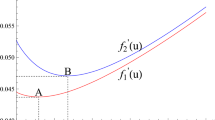Abstract
A dual model of the perturbed classical compound Poisson risk model is considered under a constant dividend barrier. A new method is used in deriving the boundary condition of the equation for the expectation function by studying the local time of a related process. We obtain the expression for the expected discount dividend function in terms of those in the corresponding perturbed compound Poisson risk model without barriers. A special case in which the gain size is phase-type distributed is illustrated. We also consider the existence of the optimal dividend level.
Similar content being viewed by others
References
Gerber H U. An extension of the renewal equation and its application in the collective theory of risk[J]. Skandinavisk Aktuarietidskrift, 1970, 53:205–210.
Gerber H U, Landry B. On the discounted penalty at ruin in a jump-diffusion and the perpetual put option[J]. Insurance: Mathematics and Economics, 1998, 22(3):263–276.
Chiu S N, Yin C C. The time of ruin, the surplus prior to ruin and the deficit at ruin for the classical risk process perturbed by diffusion[J]. Insurance: Mathematics and Economics, 2003, 33(1):59–66.
Tsai C C L. On the discounted distribution functions of the surplus process perturbed by diffusion[J]. Insurance: Mathematics and Economics, 2001, 28(3):401–419.
Zhang C, Wang G. The joint density function of three characteristics on jump-diffusion risk process[J]. Insurance: Mathematics and Economics, 2003, 32(3):445–455.
De Finetti B. Su un’impostazione alternativa della teoria collettiva del rischio[C]. In: Proceedings of the Transactions of the XV International Congress of Actuaries, 1957, Vol. 2, 433–443.
Dickson D C M, Waters H. Some optimal dividends problems[J]. ASTIN Bulletin, 2004, 34(1):49–74.
Gerber H U. On the probability of ruin in the presence of a linear dividend barried[J]. Scandinavian Actuarial Journal, 1981, 2:105–115.
Gerber H U, Shiu E S W. Optimal dividends: analysis with Brownian motion[J]. North American Actuarial Journal, 2004, 8(1):1–20.
Li S, Garrido J. On a class of renewal risk models with a constant dividend barrier[J]. Insurance: Mathematics and Economics, 2004, 35(3):691–701.
Lin X S, Willmot G E, Drekic S. The classical risk model with a constant dividend barrier: analysis of the Gerber-Shiu discounted penalty function[J]. Insurance: Mathematics and Economics, 2003, 33(3):551–566.
Avanzi B, Gerber H U, Shiu E S W. Optimal dividend in the dual model[J]. Insurance: Mathematics and Economics, 2007, 41(1):111–123.
Ioannis Karatzas, Steven E Shreve. Brownian motion and stochastic calculus[M]. New York: Springer-Verlag, c1988.
Daniel Revuz, Marc Yor. Continuous martingales and Brownian motion[M]. Berlin: Springer-Verlag, c1991.
Wang G, Wu R. Some distributions for the classical risk processes that is perturbed by diffusion[J]. Insurance: Mathematics and Economics, 2000, 26(1):15–24.
Wang G. A decomposition of the ruin probability for the risk process perturbed by diffusion[J]. Insurance: Mathematics and Economics, 2001, 28(1):49–59.
Tsai C C L, Willmot G E. A generalized defective renewal equation for the surplus process perturbed by diffusion[J]. Insurance: Mathematics and Economics, 2002, 30(1):51–66.
Asmussen S. Ruin probabilities[M]. Singapore: World Scientific Publishing Co Pte Ltd, 2000.
Asmussen S. Appied probabilty and queues[M]. New York: Springer-Verlag, 2003.
Asmussen S. Stationary distributions for fluid flow models with or without Brownian noise[J]. Stochastic Models, 1995, 11(1):21–49.
Author information
Authors and Affiliations
Corresponding author
Additional information
Communicated by GUO Xing-ming
Project supported by the National Basic Research Program of China (973 Program) (No. 2007CB814905), the National Natural Science Foundation of China (No. 10571092), and the Research Fund of the Doctorial Program of Higher Education
Rights and permissions
About this article
Cite this article
Li, B., Wu, R. The dividend function in the jump-diffusion dual model with barrier dividend strategy. Appl. Math. Mech.-Engl. Ed. 29, 1239–1249 (2008). https://doi.org/10.1007/s10483-008-0913-z
Received:
Revised:
Published:
Issue Date:
DOI: https://doi.org/10.1007/s10483-008-0913-z
Key words
- compound Poisson process
- diffusion process
- Gerber-Shiu function
- integro-differential equation
- time of ruin
- surplus before ruin
- deficit at ruin



